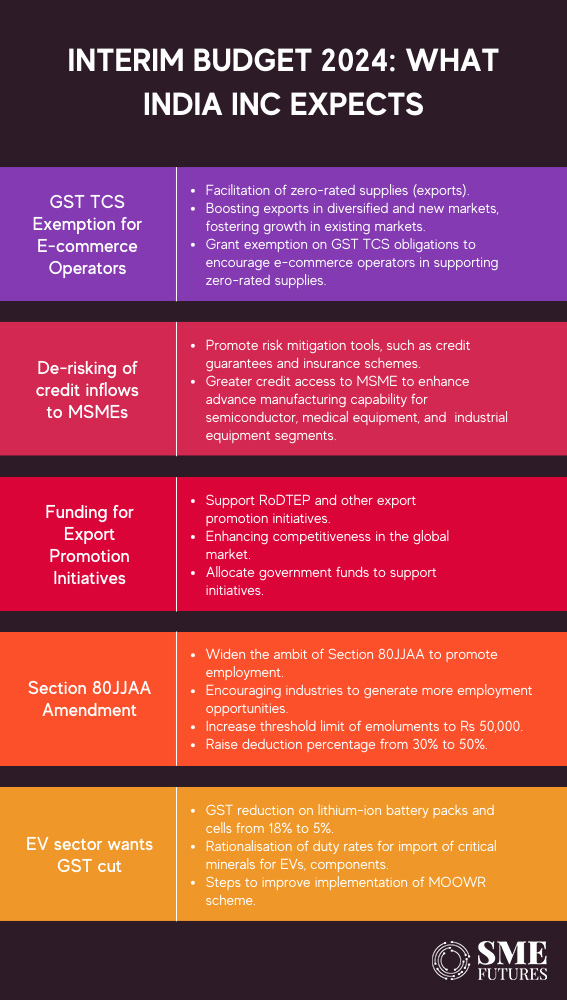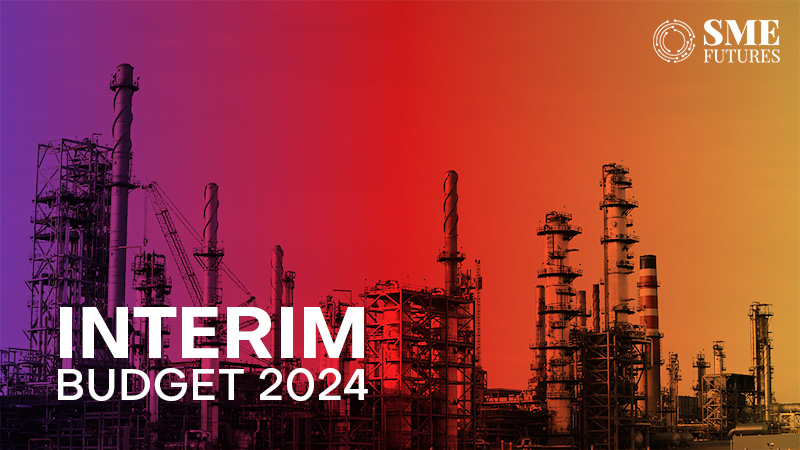India’s interim budget is almost around the corner. However, this budget is a vote on account, in which the incumbent administration seeks Parliament’s approval for necessary expenses until the next government takes office. Finance minister Nirmala Sitharaman stated (on December 7) that the Union Budget is unlikely to have any “spectacular announcements,” adding that the regular budget would be presented in July and “you would have to wait till then.”
However, India Inc. and the market are rife with speculation and anticipation. Investors, experts, and the business community are closely watching the economic landscape for hints about future policy changes and budgetary measures that could affect various industries.
Here is what they expect out of the short-term budget.
De-risking of credit inflows to MSMEs
Recent data from the Reserve Bank reveals 13.2 per cent credit growth for medium-sized industries in June 2023 (compared with 47.8 per cent the previous year), with micro and small industries experiencing a 13 per cent increase (compared with 29.2 per cent the year prior).
However, credit being one of the challenges for MSMEs is always on the agenda. Even the estimated MSME credit gap is between Rs 20 and 25 lakh crores.
Despite ongoing credit accessibility initiatives, there remains a significant need for innovative solutions to address the credit gap faced by MSMEs.
Deloitte India in its pre-budget booklet talks about de-risking of credit inflows to MSMEs in the manufacturing sector for capital investment and skill development to develop the capability for advanced manufacturing of intermediary goods.
“To reduce risks in capital flows to MSMEs, particularly in industries such as automotive, electronics (manufacturing of ICs), industrial and electrical machinery, and chemicals (that saw over 5 percent export growth from 2017 to 2022), it is advisable to promote risk mitigation tools, such as credit guarantees and insurance schemes,” say Easwaran, Partner and Supply Chain Leader and Saurabh Kanchan, Partner, Deloitte India.
GST adjustments for SME’s and Indian exporters
An increase in the minimum revenue threshold for mandatory GST registration from Rs 20 lakhs to Rs 50 lakhs will help small scale suppliers minimize their compliance costs, says Srivatsan Sridhar, Founder and CEO, Skydo, a cross border payments platform.
Additionally, there is a need for clear guidance on the necessity for GST registration of businesses that are entirely focused on exports, considering their supplies are zero-rated.
Another key expectation according to Sridhar is the simplification of the Input Tax Credit (ITC) refund process for exporters.
“The current disparity between the documentation requirements of the Foreign Exchange Management Act (FEMA) and GST is a significant hurdle. While FEMA and the RBI have eliminated the need for the Foreign Inward Remittance Certificate (FIRC), the GST department still demands the confirmation of the receipt of export remittances in foreign currency. Aligning FEMA and GST documentation requirements will facilitate smoother operations for exporters, reducing bureaucratic hurdles and expediting the refund process,” he elaborates.
Exempt GST TCS obligations
Peeyush Vaish, Partner and TMT industry leader talks about the exemption of GST TCS obligations on e-commerce operators in the Deloitte India budget booklet.
Currently, as per section 52 of the CGST Act, an e-commerce operator is required to collect TCS (tax collected at source) at 1 per cent of the net value of taxable supplies made through it by other suppliers where the consideration with respect to such supplies is to be collected by the operator. Taxable supplies do not include the exemption of nil-rated supplies but include zero-rated supplies.
“Consequently, even when there is no GST liability payable on zero-rated supplies under an LUT, e-commerce operators are required to collect GST TCS in the absence of any separate GST collection by suppliers. The supplier is required to subsequently claim a cash refund of such GST TCS collected by the e-commerce operator. This results in cash flow issues for exporters and an increase in compliances for e-commerce operators and suppliers engaged in exports,” he explains.
Vaish suggests that the government should bring suitable amendments to exempt GST TCS obligations on e-commerce operators on facilitation of zero-rated supplies, to help with the cash flow issue for exporters and facilitate the ease of compliances.
These measures and adjustments to the GST framework will help simplify processes, reduce compliance costs, and enhance operational efficiency for small businesses and exporters.

EV sector expects reduction in GST
With electric mobility gathering pace in India, EV stakeholders believe that the two-wheeler EV sector is set to cross the one million mark in 2024 which will not just increase demand but will also heighten production capabilities and the growing affordability of electric vehicles (EVs) in the country.
Hence, EV players in the market want certain policy level measures to give thrust to the sector.
“One of the key factors that could significantly bolster the Indian EV industry is a potential reduction in the GST on lithium-ion battery packs and cells from the current 18 per cent to a more favourable 5 per cent. This perspective change could hold immense promise,” says MS Chugh, Founder and Chairman of Aponyx Electric Vehicles.
By lowering the GST rate on batteries, the sector will witness a positive domino effect, making it more cost-effective for manufacturers to produce EVs.
Additionally, the imminent expiration of the FAME II subsidy program in March 2024 is a crucial concern for the EV industry.
“We expect the government to further extend the FAME II program. It is not only important to sustain the momentum that has been gained so far but will also ensure that EVs are not just a choice but are highly accessible and affordable for the masses. Extending the FAME II program will also align with the government’s ambitious goal of getting 30 per cent of all vehicles on Indian roads to be electric by 2030,” he adds.
Investors seek measures to sustain positive investment flow
Before the post-2024 election Union Budget is tabled, the interim budget will lay the foundation for sustained positive financial prospects. The investment community is eagerly awaiting a shift in sentiment towards start-up investments following an extended funding winter.
“The rationalisation of capital gains tax is sought to bolster capital inflows into the flourishing start-up landscape, which has attracted a substantial $100 billion over the last six years,” says Siba Panda, Founder and Managing Partner, ValuAble.
Despite apprehensions surrounding the recent RBI regulations impacting Alternative Investment Funds (AIF), acknowledging the role of stringent standards in reinforcing the investment ecosystem becomes imperative, he adds.
A commitment to enhanced regulatory measures, combined with aligning AIF with global standards, serves to fortify the system, a crucial element for maintaining investor enthusiasm.
“Post the interim budget of 2024, expectations abound for continued further provisions in the Union Budget 2024 that specifically cater to the start-up ecosystem. These may include simplified regulations, heightened corporate governance, and incentives tailored for Environmental, Social, and Governance (ESG) practices, all contributing to fostering sustainable growth,” he says.
Reform in labour laws
The human resource sector in India harbours specific expectations, particularly regarding policy reforms that currently pose challenges.
As per the HR leadership, a primary area of focus is the streamlining of labour laws, which were characterised as cumbersome, rigid, and difficult to follow.
Dr. Ravinder Goyal, Co-Founder, Erekrut HR Automation Solutions says that the sector anticipates reforms that would simplify these laws, making them more adaptable to the modern workplace, especially in terms of flexible working arrangements and remote work policies.
“The segment could also benefit from the refinement of the Provident Fund (PF) and Employee State Insurance (ESI) schemes. The current structures of these schemes pose administrative challenges and often result in delayed contributions and settlements. An overhaul aimed at simplifying these processes could greatly enhance operational efficiency in HR management,” he points out.
Moreover, the sector needs more supportive measures to nurture talent, specifically through enhanced tax incentives for employee training and development programmes.
“This would encourage companies to invest more in upskilling their workforce, aligning with the evolving skill demands of the digital economy. Along with this, the expansion of tax benefits under schemes like Section 80-IAC, which currently has restrictive criteria, is desired to enhance accessibility to a broader range of start-ups,” he adds.
Deep digital penetration
Connectivity- physical and digital, has been the focus area of the previous union budgets of the government and is expected to continue in the Union Budget 2024.
The next level of digital penetration needs to happen across infrastructure project sites, power plants and sub stations and should attract greater outlay on SaaS investments with a vision to reimagine infrastructure-as-a-service and manufacturing-as-a-service, feels Sandeep Goel, Managing Director, Moglix.
“There is a pressing need to inject process discipline through digital project management to taper down cost and time overruns and efficiency leakages. Further, it would be great to see greater fiscal outlay on prescriptive artificial intelligence adoption in areas of essential goods like food, dairy products, rural health care, vaccination programs, and industrial safety to zero down gaps in the amenities that people need for ease of living. The vision of the budget should be to map India’s essential goods, core sector resources, and manpower on the SaaS cloud to create a one nation, one digital supply chain ecosystem for a better quality of life,” he says.
Policies fostering innovations
The start-up community hopes for interventions to support their ecosystem. They hope particularly, for policies that will nurture India’s tech innovation ecosystem.
Abhinav Jain, Co-Founder and CEO of Almonds Ai says that the start-up ecosystem need increased investments in R&D initiatives, particularly in areas like AI, robotics, and advanced materials.
“Additionally, incentives for attracting and retaining skilled tech talent through tax breaks for skill development programmes and simplified visa processes would be greatly appreciated. The budget should act as a catalyst for India’s burgeoning start-up ecosystem. We urge the government to consider easing regulations for start-ups, simplifying the funding process, and creating avenues for easier access to angel investors and venture capital,” he says.











